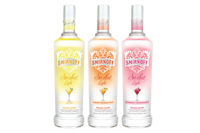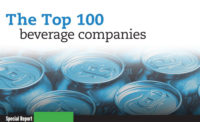![]()
2003 Liquor Report
by Jennifer Korolishin
|
Younger consumers drive spirits growth
Spurred by growing
popularity among younger consumers and numerous
flavored product introductions, 2003 was a good year for distilled spirits.
Led by Cognac, vodka, rum and tequila, spirits sales increased 4 percent in
2003 to more than $41.4 billion; volume grew 3.1 percent to nearly 1.4
billion liters, according to Euromonitor International.
Given the uncertain U.S. economy, consumers were
expected to cut back on luxury items like spirits. However, spirits’
2003 performance indicates that consumers
are optimistic about a possible economic upturn and are retaining their
preference for even super-premium priced spirits.
Spirits have also undergone an image transformation
that continues to drive sales and volume. While classic cocktails enjoyed a
brief 1990s revival, spirits are now positioned as a key ingredient in
newer specialty drinks that are more relevant to younger consumers,
particularly the 21 to 28 age group.
Cognac’s popularity surges
Thanks to hip-hop songs like Busta Rhymes’
“Pass the Courvoisier,” Cognac and brandy have experienced a
sharp increase in interest from young and urban audiences. Cognac and
brandy regularly appear in rap and hip-hop videos, giving those segments a
trendy, sophisticated image among younger consumers. In 2003, combined brandy and Cognac volume increased 3.1 percent, while sales
climbed 4.7 percent. The marriage of music and spirits is expected to
strengthen during the next year. Among the deals struck in 2003, William
Grant & Sons licensed the new Armadale Vodka brand to Roc-A-Fella
Records, home to top-selling rap artist Jay-Z. Roc-A-Fella promotes the
product while William Grant handles production.
Liqueurs also remained popular in 2003, growing 1.5
percent in volume and posting a 2.7 percent sales increase to $5.7 billion.
Bailey’s Irish Cream and Jagermeister are among the strongest premium
liqueur brands.
A dash of flavor propels rum sales
Rum is a star in the spirits category, as the introduction of
flavored rums increased its popularity as both a mixer and a stand-alone drink
among younger consumers. Rum sales grew 5.4 percent in 2003 to $4.6 billion,
and volume increased 4.7 percent. Its sweeter taste and versatility in mixed
drinks drives rum’s appeal among younger consumers. Last year saw the introduction
of numerous flavored rums, notably Bacardi Flavored Rum Razz, Vanilla and Coco,
extensions of the manufacturer’s popular Limon and orange-flavored Bacardi O
brands. In terms of brands, the rum category is largely a battle for market
share between No. 1 Bacardi and No. 2 Captain Morgan, with Malibu a distant
third. While Bacardi’s lead remains solid, Captain Morgan has recently gained
market share due to aggressive marketing and a more developed line of flavored
products.
Where rum experienced great success in 2003, tequila
is recovering from a dramatic shift in popularity. After growing steadily
throughout the 1990s, tequila sales took a nosedive in 2001, in part
because consumers switched to more au courant spirits like rum or vodka. In 2003, tequila showed
improvement. Volume, spurred by a rise in sales of premium brands such as
Jose Cuervo Gran Reserva and Viuda de Romero Resposado Premium Tequila,
increased 8.2 percent to 72.4 million liters and sales grew 9.2 percent to
reach $2.1 billion. Jose Cuervo is the largest U.S. tequila brand and the
sixth-largest overall distilled spirits brand by volume.
Strong vodka performance hurts gin
Among white spirits, vodka is the clear leader. Vodka
sales grew 6 percent in volume to 385 million liters and increased sales
6.9 percent to $9.8 billion in 2003, according to Euromonitor. Value growth
outpaces volume gains in the vodka category as consumers increasingly trade
up to premium brands such as Belvedere, Grey Goose and Stolichnaya,
although general demand also lifted sales of standard-priced brands.
Smirnoff, the leading vodka brand by volume and the second-largest spirits
brand overall, has seen steady growth during the past two years.
Like rum, vodka is a versatile mixed drink ingredient,
as evidenced by the popularity of vodka martinis, vodka gimlets, vodka
tonics and Cosmopolitans. Flavored vodkas are driving the category’s
surge, as they can be consumed alone or in mixed drinks. Citrus flavors
such as lemon and orange are popular, as is vanilla. Notable new product
rollouts in 2003 included Stolichnaya Stoli Cranberi and Stoli Citros, Skyy
Flavored Vodka and Absolut Vodka Vanilia.
As vodka has grown, gin has suffered. In the United
States, gin is primarily consumed in mixed drinks, but consumers are
replacing gin with vodka in traditionally gin-based drinks such as gin
gimlets and gin martinis. Also, due to its strong juniper berry taste,
there are few flavored gins on the market. In 2003, gin volume remained
largely flat, posting only a 0.6 percent gain. Sales increased 1.4 percent
to $2.7 million, bolstered by the fact that consumers are choosing premium
brands such as Bombay Sapphire and Beefeater.
Irish whisky a standout
In the whiskey category, premium and super-premium products
such as single-malt Scotch whisky gained the most in 2003. While the category
remained largely flat, Irish whisky saw a 7.8 percent increase in volume, and
a 9.1 percent sales increase to $240 million. This is due in part to the fact
that Irish whisky is a relatively immature segment in the United States, since
its market penetration is not as great as U.S. bourbon, Canadian whisky and
Scotch whisky. The segment is dominated by Pernod Ricard USA’s Jameson brand
family. While it remains the single largest U.S. distilled spirits subsector,
whiskey has lost ground to trendier drinks. Overall, whiskey volume increased
only 0.3 percent in 2003 and posted a 1.3 percent sales increase to $11.4 billion,
due mostly to premium and super-premium brand sales.
Diageo leads spirits category
Overall, Diageo plc is the spirits category
leader, controlling 19.3 per-cent of volume in 2002, with brands including
Captain Morgan rum, Seagram’s 7 Crown U.S. whiskey, Smirnoff vodka
and Jose Cuervo
tequila. Jim Beam Brands Worldwide Inc. was the second-largest U.S. distilled
spirits company in 2002, accounting for 9.4 percent of volume. Round-ing out
the top three, Constellation Brands, manufacturer of the Barton and Black Velvet
whiskey brands, held 8.4 percent of volume in 2002.
| Top 20 brand shares of spirits (% total volume) | ||
| Global brand | Company | Market share (2002) |
| Bacardi | Bacardi & Co | 5.3 |
| Smirnoff | Diageo North America | 4.7 |
| Absolut Vodka | Future Brands LLC | 3.1 |
| Jack Daniel's | Brown-Forman Corp. | 2.5 |
| Captain Morgan | Diageo North America | 2.3 |
| José Cuervo | Diageo North America | 2.2 |
| Jim Beam | Jim Beam Brands Worldwide | 2.1 |
| Crown Royal | Diageo North America | 2.0 |
| Seagram's Gin | Pernod Ricard USA | 1.9 |
| De Kuyper | Jim Beam Brands Worldwide | 1.7 |
| Seagram's 7 Crown | Diageo North America | 1.7 |
| Gordon's | Diageo North America | 1.6 |
| E & J | E & J Gallo Winery | 1.6 |
| Canadian Mist | Brown-Forman Corp. | 1.5 |
| Barton | Constellation Brands Inc. | 1.2 |
| Black Velvet | Constellation Brands Inc. | 1.2 |
| Hennessy | Schieffelin & Somerset Inc. | 1.2 |
| McCormick | McCormick Distilling Co. Inc. | 1.2 |
| Popov | Diageo North America | 1.1 |
| Stolichnaya | Allied Domecq Spirits USA | 1.1 |
| Source: Euromonitor International, Chicago | ||
| Sales of spirits by subsector: total volume 2003 | ||
| Category | 2003 (000 litres) | |
| Whisk(e)y | 393,602.9 | |
| Single malt Scotch whisky | 7,192.9 | |
| Blended Scotch whisky | 76,134.5 | |
| Bourbon/other U.S. whiskey | 168,572.7 | |
| Canadian whisky | 137,395.1 | |
| Irish whisky | 4,307.7 | |
| Brandy and Cognac | 91,701.1 | |
| Brandy | 59,798.7 | |
| Cognac | 31,902.4 | |
| White spirits | 484,967.4 | |
| Gin | 99,912.1 | |
| Vodka | 385,055.3 | |
| Rum | 176,556.2 | |
| White rum | 98,302.1 | |
| Dark rum | 78,254.1 | |
| Tequila (and mezcal) | 72,425.3 | |
| Liqueurs | 159,287.4 | |
| Cream-based liqueurs | 23,508.4 | |
| Bitters | 10,471.8 | |
| Other liqueurs | 125,307.2 | |
| Other spirits | 11,656.8 | |
| Total Spirits | 1,390,197.1 | |
| Source: Euromonitor International, Chicago | ||
| Sales of spirits by subsector: total value 2003 | ||
| Category | 2003 (U.S.$ million) | |
| Whisk(e)y | 11,354.4 | |
| Single malt Scotch whisky | 583.0 | |
| Blended Scotch whisky | 2,502.1 | |
| Bourbon/other U.S. whiskey | 4,441.5 | |
| Canadian whisky | 3,587.9 | |
| Irish whisky | 239.9 | |
| Brandy and Cognac | 4,748.8 | |
| Brandy | 1,581.5 | |
| Cognac | 3,167.3 | |
| White spirits | 12,505.6 | |
| Gin | 2,684.4 | |
| Vodka | 9,821.2 | |
| Rum | 4,630.0 | |
| White rum | 2,458.1 | |
| Dark rum | 2,171.9 | |
| Tequila (and mezcal) | 2,139.5 | |
| Liqueurs | 5,662.5 | |
| Cream-based liqueurs | 809.7 | |
| Bitters | 426.6 | |
| Other liqueurs | 4,426.2 | |
| Other spirits | 442.0 | |
| Total Spirits | 41,482.8 | |
| Source: Euromonitor International, Chicago | ||

